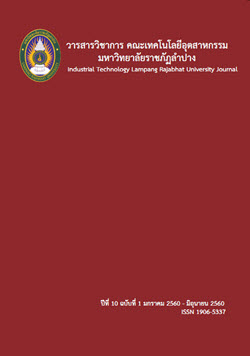การพัฒนาเนื้อดินและเคลือบเซรามิกอุณหภูมิต่ำ สำหรับผลิตเป็นจอกรองน้ำยางพารา ของกลุ่มผลิตเครื่องปั้นดินเผาบ้านวังดินสอ
Keywords:
จอกรองน้ำยางพารา, เคลือบเซรามิคอุณหภูมิต่ำ, บ้านวังดินสอ, rubber cup, low temperature ceramic glazing, Wangdinsor VillageAbstract
การวิจัยนี้มีวัตถุประสงค์เพื่อพัฒนาเนื้อดินและเคลือบเซรามิกอุณหภูมิต่ำ สำหรับผลิตเป็นจอกรองน้ำยางพารา มีวิธีดำเนินการวิจัยเป็น 3 ขั้นตอนคือ ขั้นตอนที่ 1 การทดสอบสมบัติของเนื้อดินที่มีอัตราส่วนผสมระหว่างวัตถุดิบ 3 ชนิด คือ ดินบ้านวังดินสอ ตำบลวังนกแอ่น อำเภอวังทอง จังหวัดพิษณุโลก ร่วมกับ โปแตสเฟลด์สปาร์ และทราย ได้จากการเลือกแบบเจาะจง จากตารางสามเหลี่ยม ได้กลุ่มตัวอย่าง 36 ตัวอย่าง ขั้นตอนที่ 2 การทดสอบสมบัติของสูตรเคลือบที่มีอัตราส่วนผสมระหว่าง ฟริต โปแตสเฟลด์สปาร์ และควอทซ์ ได้มาจากการเลือกตัวอย่างแบบเจาะจง จากจำนวน 26 ตัวอย่าง ขั้นตอนที่ 3 การผลิตจอกรองน้ำยางพาราและสอบถามความพึงพอใจของเกษตรกรผู้ใช้
ผลการวิจัยพบว่า 1) ค่าการหดตัวของเนื้อดินอยู่ระหว่างร้อยละ 6.00 - 14.00 ค่าความแข็งแรง อยู่ระหว่าง 33.00-80.52 (ก.ก./ซ.ม.2) และค่าการดูดซึมน้ำ อยู่ระหว่างร้อยละ 3.95-19.33 ตัวอย่างที่มีค่าความหดตัวสูงสุดร้อยละ 14 ตัวอย่างที่มีค่าความหดตัวน้อยที่สุด ร้อยละ 6 ตัวอย่าง ที่มีค่าความแข็งแรงสูงสุด 80.52 ก.ก./ซ.ม.2 ตัวอย่างที่มีค่าความแข็งแรงต่ำสุด (33.00 ก.ก./ซ.ม.2) ตัวอย่างที่มีค่าการดูดซึมน้ำสูงสุด ร้อยละ19.33 ตัวอย่างที่มีค่าการดูดซึมน้ำต่ำสุด ร้อยละ 4.87 2) ลักษณะของเคลือบภายหลังการเผาที่อุณหภูมิ 900 องศาเซลเซียส ส่วนใหญ่สุกตัว และมีระดับมันแวววาว รองลงมา คือ ระดับกึ่งด้านกึ่งมันและระดับด้าน เกิดตำหนิรูเข็ม เคลือบแยกตัว ฟองอากาศ และ 3) เกษตรกรที่ได้ทดลองใช้งานมีความพึงพอใจทุกด้านในระดับมาก โดยมีค่าเฉลี่ยความพึงพอใจเกี่ยวกับน้ำหนักของจอกรองน้ำยางพารา สูงสุด (ค่าฉลี่ย = 4.3, SD = 0.823) รองลงมา ได้แก่ ความพึงพอใจด้านการใช้งาน (ค่าฉลี่ย = 4.0, SD= 0.667) และขนาดของจอกรองน้ำยางพารา (ค่าฉลี่ย =3.8, SD= 0.633) ตามลำดับ มีข้อเสนอแนะให้เคลือบทั้งด้านนอกและด้านในผลิตภัณฑ์
The development of low temperature Ceramic Bodies and ceramic glazes for the Development of a Rubber Latex collecting Cup of Ban Wangdinsor Pottery Community
This research aims to develop ground texture and low temperature ceramic coating and production of a rubber screen. There are 3 steps to perform the research. The first step was to create a mixture of ceramic body made from 36 samples from wangdinsor clay, feldspar and sand. Step 2 was to develop a glaze recipe for the body from 26 samples from frit, feldspar and quartz. Step 3 involved the production of rubber cup selected from the results of step 1 and step 2 and to gauge levels of satisfaction from the trial use.
The results showed that:
1)The shrinkage of the ceramic body was between 6% and 14%. The strength is between 33.00 to 80.52 (kg/cm2) and the water absorption ranged from 3.95% to 19.33%.
2) The characteristics of the glazing found that 15 recipes are bright, 8 recipes are semi-matt and the 3 recipes are matt. The melting test found that sample 19, 24, 25, 26 are non-melting. The defect of glazing found a pinhole for 14 samples and blister for 15 samples.
3) The analysis of user satisfaction for the rubber cup found that the ceramics body recipes (80% wangdinsor clay, 5% feldspar, 15% sand) and glaze recipes (75% frit, 20% feldspar, 5% quartz) were found to have satisfied all the more satisfying by the weight of the rubber cup ( Arithmetic Mean = 4.3, SD= .823), the applications ( Arithmetic Mean = 4.0, SD= .667) and the size ( Arithmetic Mean = 3.8, SD= .633). Respectively with the suggestion of the user to make the glaze, both outside and inside.






